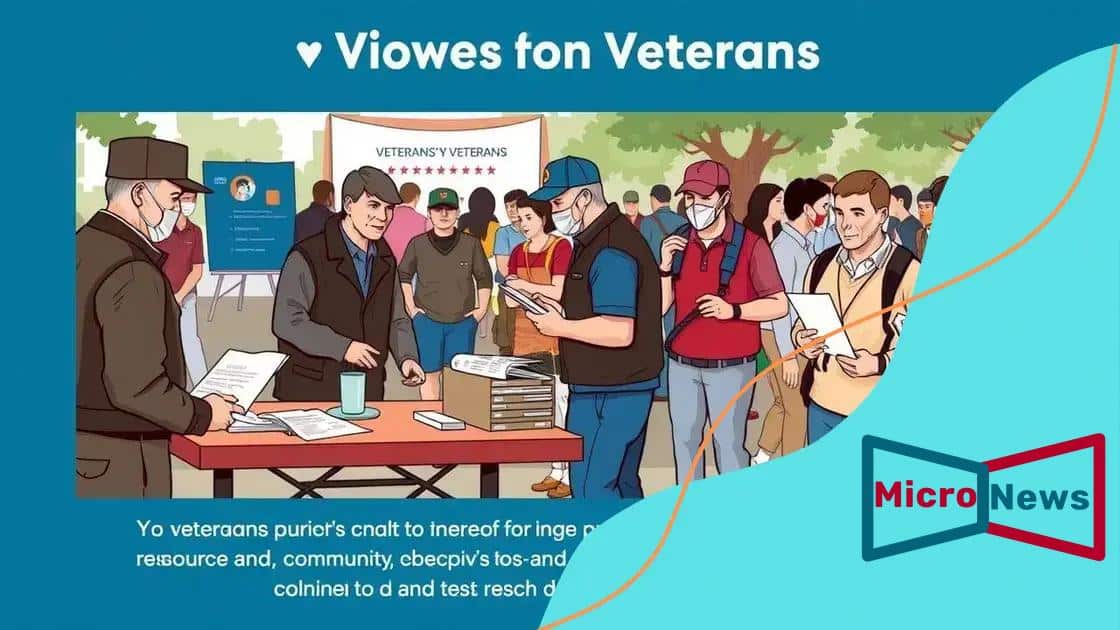Veterans’ healthcare and benefit access improvements are essential

Veterans’ healthcare and benefit access improvements are achieved through enhanced technology, streamlined policies, and supportive community programs, ensuring veterans receive timely and high-quality services tailored to their needs.
Veterans’ healthcare and benefit access improvements are critical topics that affect countless lives. Have you ever wondered how recent changes have started to reshape the experience for veterans seeking health services? Let’s dive in!
current challenges in veterans’ healthcare
Veterans face many current challenges in healthcare, making it difficult for them to receive the services they deserve. Understanding these challenges helps us find ways to improve support for our veterans.
Healthcare Accessibility
One of the biggest hurdles is healthcare accessibility. Many veterans live in rural areas where medical facilities are scarce. Transporting them to clinics can be a challenge. Additionally, long waiting times for appointments can lead to delayed treatments.
Awareness of Benefits
Another issue is the lack of awareness about available benefits. Veterans often don’t know what services they are entitled to, which results in underutilization. Education about options is crucial. A few key points include:
- Access to mental health services.
- Programs offering job training and rehabilitation.
- Support for family members of veterans.
Furthermore, the complex nature of the benefits application process can deter veterans from seeking help altogether. Simplifying this process is vital to ensure that all eligible veterans access the support they need.
Quality of Care
Lastly, the quality of care provided also poses a challenge. Veterans deserve high-quality treatment, yet inconsistency can occur due to staffing shortages or overburdened healthcare providers. Ensuring that veterans receive appropriate and timely care is essential for their recovery and well-being.
These are just a few of the significant challenges veterans face in healthcare today. Understanding them is the first step toward creating solutions that work for our veterans.
recent advancements in benefit access
Recent advancements in benefit access have made a significant impact on the lives of veterans. These changes enhance how veterans receive essential services and support.
Streamlined Application Processes
One important development is the streamlining of application processes for benefits. Many veterans found the previous system confusing and lengthy. Now, many organizations are implementing user-friendly online platforms where veterans can apply for benefits easily. This shift has made it more accessible for veterans to get the help they need.
Increased Outreach Programs
Moreover, there have been increased outreach programs aimed at ensuring that veterans are aware of the benefits available to them. Many non-profits and government organizations conduct regular information sessions. Here are a few key benefits they cover:
- Healthcare options, including mental health support.
- Education assistance and job training programs.
- Housing benefits and financial support.
Such outreach efforts play a crucial role in increasing veterans’ participation in available programs. Many veterans report that, thanks to these programs, they are now utilizing benefits they were previously unaware of.
Technology Integration
Technology also plays a vital role in these advancements. Apps and online portals allow veterans to track their application status in real time. This transparency fosters trust and reduces anxiety during the waiting period. Many veterans appreciate being informed about their progress, which encourages them to seek help when needed.
As advancements continue, we can expect even more improvements in how veterans access their benefits. With dedicated efforts from various organizations, the future looks promising for enhancing benefit access for our veterans.
community programs supporting veterans

Community programs play a vital role in supporting veterans. These initiatives provide essential resources and build a network of support that can significantly improve veterans’ lives.
Types of Community Programs
There are various types of community programs designed specifically to assist veterans. These programs offer a range of services tailored to meet the needs of the veteran population.
- Employment assistance and job training programs.
- Support groups for mental health and wellness.
- Housing assistance programs to help with finding stable living situations.
Many veterans have successfully transitioned to civilian life thanks to these kinds of initiatives. They provide guidance on navigating challenges and accessing necessary services.
Local Organizations Making a Difference
Local organizations often lead the charge in creating and implementing these community programs. They address specific needs and foster strong relationships among veterans. One prominent example is job training offered through non-profits that connect veterans with potential employers. This helps veterans to showcase their skills and find meaningful work.
Another area of focus is mental health services. Organizations offer support groups and counseling, acknowledging the importance of mental health in the transition process. Through these programs, veterans feel empowered to speak about their experiences and connect with others who understand their struggles.
Community support extends beyond just the veterans themselves. Family members of veterans also benefit through programs that educate them on available resources, ensuring that the entire family unit is supported. Building a network in the community creates a safety net for veterans and their families.
Ultimately, community programs are crucial for enhancing the well-being of veterans. They provide not only resources but also connection and understanding.
the role of technology in improving services
The role of technology in improving services for veterans is crucial. Innovations have transformed how veterans access healthcare and benefits, making the process much more efficient.
Digital Health Records
One significant advancement is the implementation of digital health records. This allows for quick and seamless access to a veteran’s medical history. Healthcare providers can view all necessary information, which leads to better decision-making and more personalized care. With just a few clicks, providers can assess treatment plans and coordinate services with ease.
Telehealth Services
Another impactful change is the rise of telehealth services. Veterans can now consult with healthcare professionals from the comfort of their homes. This is especially beneficial for those in rural areas where healthcare facilities are limited. The convenience of telehealth has led to improved attendance at appointments and better health outcomes.
Additionally, many organizations have developed mobile apps to help veterans manage their healthcare needs. These apps provide features like appointment booking, medication reminders, and access to health resources. This tech-driven approach empowers veterans to take control of their health and stay informed.
Online Benefits Management
Technology has also streamlined the benefits application process. Veterans can apply for benefits online, reducing wait times and complexity. This quick access encourages more veterans to seek the assistance they need. Furthermore, tracking the status of applications online adds transparency, helping veterans to feel more engaged with the process.
Moreover, social media platforms and veteran-focused websites serve as valuable resources. They connect veterans to support networks and share information about available services. These platforms foster a sense of community and belonging among veterans.
As technology continues to evolve, its influence on the services available to veterans will only strengthen, improving their overall experience.
impact of policy changes on healthcare access
The impact of policy changes on healthcare access for veterans is significant. Recent reforms aim to improve the services and support available to those who have served.
Improved Coverage Options
One notable change is the expansion of healthcare coverage options. Policies now allow veterans to access a wider variety of services, including mental health care and preventive services. This holistic approach ensures that veterans receive comprehensive care tailored to their needs.
Accessibility Enhancements
Furthermore, policy changes have focused on increasing accessibility. Veterans can now receive care closer to their homes through new partnerships with local healthcare providers. These partnerships help to reduce travel time and improve the overall efficiency of healthcare delivery.
- Increased funding for community-based clinics.
- Transportation assistance programs for veterans living in rural areas.
- Telehealth services that connect veterans with healthcare professionals remotely.
This shift in focus enables veterans to receive timely interventions, which is crucial for maintaining their health. By making services more accessible, policies are helping to bridge the gap between veterans and the healthcare they need.
Streamlined Application Processes
Additionally, changes in policy have led to streamlined application processes for veterans seeking benefits and services. Complex paperwork that once created barriers is now simplified. This encourages veterans to utilize the benefits available to them without unnecessary hurdles.
As a result, more veterans are applying for benefits, leading to increased participation in programs designed to support them. The policy changes have opened doors that were previously closed, fostering a greater awareness of the resources available.
The combined effect of these policy changes has contributed to a noticeable improvement in veterans’ access to healthcare services. These changes not only enhance the quality of care but also ensure that veterans feel respected and valued.
FAQ – Frequently Asked Questions about Veterans’ Healthcare and Benefit Access Improvements
What are the main healthcare challenges faced by veterans?
Veterans often encounter challenges such as limited accessibility to care, long waiting times, and a lack of awareness about available benefits.
How has technology improved healthcare access for veterans?
Technology has streamlined services through digital health records, telehealth consultations, and online benefits applications, making it easier for veterans to receive care.
What role do community programs play in supporting veterans?
Community programs provide vital resources, including job training, mental health support, and housing assistance, ensuring veterans and their families receive the help they need.
How have policy changes impacted veterans’ access to benefits?
Policy changes have expanded coverage options, simplified application processes, and increased funding for services, making it easier for veterans to access the benefits available to them.





